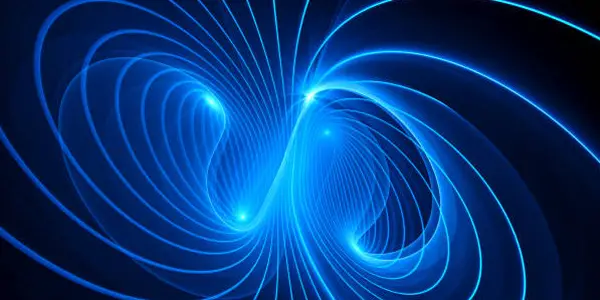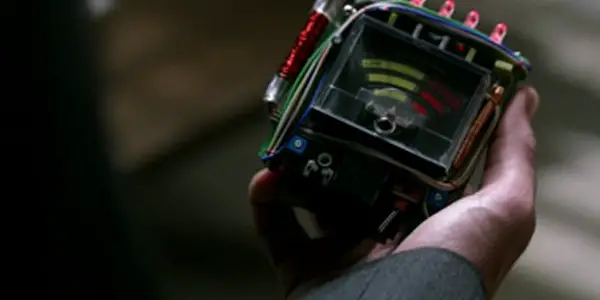Fantasy Science Pt. 15: SUPERNATURAL & EMF Detectors

Radha has a PhD in theoretical quantum physics. Apart from…
Electromagnetism. Force. EMF. Have you heard terms like these flying around the science fiction sections of the film/tv world? Have you ever wondered just how accurately these films portray real science? Well, my friends, today is your lucky day: this column, Fantasy Science & Coffee, aims to bridge the gap between science and science fiction in films and popular culture. My hope is to explain things in a fun way – like we’re chatting over coffee.
You may be thinking: who is this person, why does she think she can explain science, and why the heck would I want to have coffee with her? Well, I’m Radha, a researcher in India, currently pursuing a PhD in theoretical quantum physics. I quite like hot beverages. I’ll also pay.

In this fifteenth part of the series published on the second and fourth Tuesdays of every month, we are going to look at a tool that Sam and Dean Winchester of Supernatural use very frequently: the EMF detector. Let’s begin.
EMF Detectors in Supernatural
Fans of the TV show Supernatural and other film/tv that involves, well, the supernatural, are no strangers to devices called “EMF detectors”. These are nifty handheld apparatuses that detect changes in electromagnetic fields (EMFs), which are thought to be caused by ghosts. Given the Winchester brothers’ tendency to encounter murderous ghosts, without these handy gadgets, they’d likely die more often than they already do. (And the prize for repeatedly dying and not staying dead goes to…)
Interestingly, real ghost hunters and enthusiasts apparently use EMF detectors as well, but the jury is still out about whether supernatural phenomena in real life actually cause such fluctuations – provided the phenomena are real at all!
Let’s avoid a debate on whether ghosts are real, shall we? Instead, let’s focus on the science behind EMF detectors.
What is an Electromagnetic Field (EMF)?
Before I begin, I want you to know just how difficult it is to visualize a field, because it isn’t a physical entity. Sure, we physicists know how to calculate fields and work with them, but coming up with a descriptive analogy is difficult — and not entirely an accurate thing to do. I actually threw out a number of my visualization ideas while editing this little chat of ours. Physicist David Griffiths said this about the electric field in his book on electrodynamics:
But I encourage you to think of the field as a “real” physical entity, filling the space in the neighbourhood of any electric charge. Maxwell himself came to believe that electric and magnetic fields represented actual stresses and strains in an invisible primordial jellylike “ether”. Special relativity has forced us to abandon the notion of ether, and with it Maxwell’s mechanical interpretation of electromagnetic fields. I can’t tell you, then, what a field is — only how to calculate it and what it can do for you once you’ve got it.
First off, the word field in this context isn’t a vast expanse of grass and flowers with frolicking deer; it can be thought of instead as a fabric that extends in all directions, emanating from particular objects or collections of objects. Moving electrically charged particles, like the currents that run through your home’s wiring, generate both electric and magnetic fields, giving rise to electromagnetic fields (EMFs). Stationary electrically charged particles only produce electric or electrostatic fields.
The moving charged particles influence and interact with one another. This interaction can be visualized as ripples emanating from the particles and propagating along the fabric. The ripples interfere with one another and in turn collectively influence or push around the charged particles. Disturbances, like introducing new charged particles, cause fluctuations in the EMF.

Mathematically, an EMF is something that describes this interaction, and is actually a description of the electromagnetic force. The interactions among charged particles are due to the EM force, which is one of the four fundamental forces that make our universe tick. The others are the gravitational force, which is why apples fall from apple trees and hit lounging physicists on the head, the strong force, which holds the nucleus together, and the weak force, which governs radioactive decay.
Now that you’ve got a basic grasp of an EMF, let’s move away from the fabric analogy, since a field isn’t actually a tangible entity. You can instead think of it as a region of influence around charged particles. For each point in this region, there’s an associated number and arrow. For an EMF, the number and arrow at a point are the magnitude and direction of the EM force at that point. You can visualize an EMF to be a bunch of arrows in a region around charged particles like this:

A charged particle at point A would experience a smaller force because it’s surrounded by smaller arrows, whereas a charged particle at point B would experience a greater force in the direction of the larger arrows that surround it. The arrows point in the direction in which a positively charged particle would be pushed.
Now, let’s look at interactions closely, since they are precisely what a field describes. Pretend you jump into a ball pit, in which each ball is not actually just a plain old plastic ball, but is a magnet. If you ever had the good fortune to play with magnets as a kid, you might remember that stuff happens when you bring magnets together. They attract and repel one another depending on how you move them. There’s a sort of pushing and pulling going on, which are actually magnetic forces at play. Each ball in the pit experiences a force that is a collective effect of all the other balls in the pit, and when you jump in, you’ll cause a flurry of movement because of the disturbance.
A similar thing would happen if the balls are not magnets but electrically charged particles. If they are stationary, there would only be an electrostatic field. However, if they are moving, as they would when you jump in, they’d also generate a magnetic field because all moving electrical charges generate magnetic fields.
If you step out of the pit and take one of the electrically charged particles with you, the particle would feel less and less of a tug from the pit as you move away because the influence of the field generated by the particles in the pit would reduce. Away from the pit, there’s no way for the particles in the pit to interact with or exert a force on the particle in your hand. The strength of the pit’s EMF at that point is zero — though I should mention that we are constantly surrounded by EMFs given the devices and electricity that we use, so the particle would likely be influenced by some field.
Another good way to visualize fields is given in this video by Scientific American:
EMF Detectors and Ghosts
EMF detectors are devices that detect changes in the EMF caused by alternating current, the type of current running in your home and through appliances like the microwave. It can pick up any changes or anomalies, and is used by electricians and engineers to diagnose problems in electrical wiring, power lines, etc.

The reason ghost hunters swear by these gadgets is because they believe ghosts are electrically charged, and therefore cause EMF fluctuations that can be detected. Interestingly, Professor Johnjoe McFadden of the University of Surrey believes that our consciousness is a manifestation of the brain’s EMF, something he proposed in his 2001 paper, “Synchronous firing and its influence on the brain’s electromagnetic field: evidence for an electromagnetic field theory of consciousness”.
From his abstract:
The human brain consists of approximately 100 billion electrically active neurons that generate an endogenous electromagnetic (em) field, whose role in neuronal computing has not been fully examined.
…
The brain’s em field represents an integrated electromagnetic field representation of distributed neuronal information and has dynamics that closely map to those expected for a correlate of consciousness. I propose that the brain’s em information field is the physical substrate of conscious awareness — the cemi field — and make a number of predictions that follow from this proposal.
It is perhaps this EMF that may linger on after death, that Sam and Dean Winchester believe they are detecting when they hunt ghosts. I suppose you’ll have to ask them.
What are some other interesting electromagnetic applications in science fiction film and tv that you’ve seen?
Note: the field of electromagnetism is extremely vast, and this isn’t even the tip of the iceberg. If you’d like more articles explaining more EM concepts, let me know in the comments below!
More to Explore
EMF Detector Apps
Ultimate EMF Detector Free on Google Play
Electromagnetic Detector EMF on the App Store
Note: I’m including these because I thought it might be a fun exercise to try some EMF detecting apps, but I’m not sure how accurate they are.
Articles
MIT news: Monitoring electromagnetic signals in the brain with MRI (2018)
io9: Meet the EMF meter, the little tool that ghost hunters swear by (2012)
Papers
Journal of Consciousness Studies: Synchronous firing and its influence on the brain’s electromagnetic field: evidence for an electromagnetic field theory of consciousness, by Johnjoe McFadden (2001)
Books
Introduction to Electrodynamics by David J. Griffiths
Resources
Exploration environment for concepts in physics: Hyperphysics (by GeorgiaState University)
HowStuffWorks: Ghost detecting equipment
Does content like this matter to you?
Become a Member and support film journalism. Unlock access to all of Film Inquiry`s great articles. Join a community of like-minded readers who are passionate about cinema - get access to our private members Network, give back to independent filmmakers, and more.
Radha has a PhD in theoretical quantum physics. Apart from research, she consults on sci-fi screenplays/books. In her free time, she cosplays and irritates her three cats. Bug her on Twitter: @RadhaPyari









